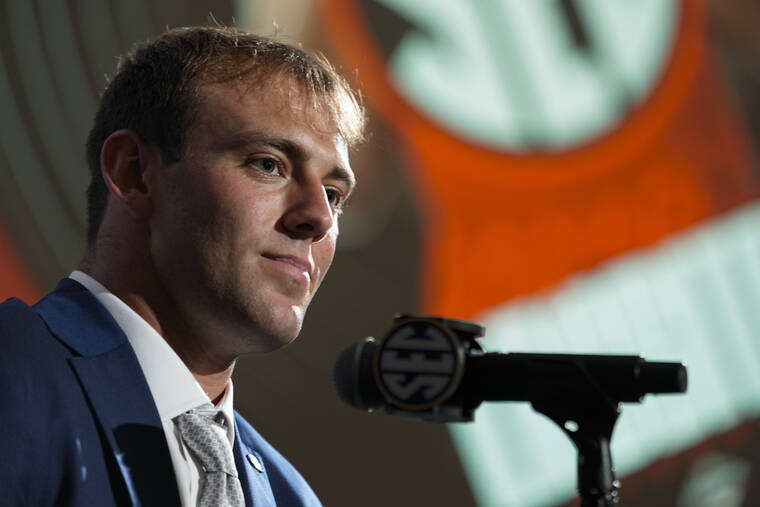Debate over tight end value hovers over Brock Bowers’ draft prospects
Evaluating Brock Bowers the player is a fairly straightforward assignment.
As he showed in three seasons at Georgia, Bowers is a dynamic receiver with the ability to create separation, make contested catches and create big plays after the catch, along with being a more than capable blocker.
ADVERTISING
Bowers is widely considered one of the top 10 players in next week’s NFL draft but because he plays the lower-premium position of tight end, there is much more uncertainty about how high he will get drafted.
While there could be teams in the top 10 willing to make the rare investment in a tight end, there is also the distinct possibility Bowers slips in the first round as teams prioritize high-value positions like quarterback, wide receiver, pass rusher, tackle or cornerback. Bowers is currently favored to be drafted outside the top 10, according to BetMGM Sportsbook.
“He is tough. He is easy to grade. I mean, when you watch him, he’s super easy to grade. He is one of the best 10 players in the draft,” said NFL Network draft analyst Daniel Jeremiah, who compared Bowers to All-Pro George Kittle and praised his tenacity, speed, ability to create separation and run after the catch.
“The challenge is then figuring out where does he go in the draft, and I think when you look around the league and you see most of these top tight ends that have come on day two or even beyond that, teams are now saying, ‘OK, we can find that other tight end. Maybe we don’t get the top guy, but we can get a really, really good player who might end up being the top guy without having to pay that premium.”
Of the top 15 tight ends in receptions last season, only four were first-round picks with only Buffalo rookie Dalton Kincaid and Cleveland’s David Njoku doing it for the team that drafted them. Five others were picked on the second day of the draft, with six more going the final day.
In all, 12 tight ends have been taken in the first round of the past 15 drafts with only one of those players — Atlanta’s Kyle Pitts — generating even one 1,000-yard receiving season. Njoku is the only one of seven first-round tight ends from 2014-20 to get a second contract with his team. The last draft with a first-round tight end who became a first-team All-Pro was 2003 with Dallas Clark of the Indianapolis Colts.
The question is can Bowers be the outlier in a class that has no other tight ends projected to go in the first round of the draft.
In three seasons at Georgia, he caught 175 passes for 2,538 yards in 40 games and scored 31 total touchdowns — five of them coming as a runner as the Bulldogs did whatever they could to get the ball in his hands.
“He’s not a tight end. He’s a multiple option player,” said ESPN draft analyst Mel Kiper Jr., who ranked Bowers as the seventh-best player in the draft. “You can put him in the backfield, slot, wing, outside, any which way, fullback, H-back. You can do anything you want with Brock Bowers. So he is not a tight end, he’s just an offensive weapon.”
Teams have been reticent about using high picks on tight ends, with just three going in the top 10 of the past 15 drafts — fewer than every position in that span outside of safeties, centers and specialists. Only nine other tight ends went in the first round since 2009, with the 12 total first-round picks ranking ahead of centers (10) and specialists.
With the rookie wage scale slotting salaries by pick regardless of position, it is more difficult for teams to generate surplus value by taking a tight end. Only two of the 126 players making an average of more than $15 million a year, according to Spotrac, are tight ends: Darren Waller and T.J. Hockenson.
Many of the top tight ends in the NFL have been picked on days two and three of the draft, including 2013 third-rounder Travis Kelce, 2017 fifth-rounder Kittle and even Sam LaPorta, who lasted until the second round last year for Detroit.
The payoff has been mostly underwhelming for the first-rounders, with none of those players earning first- or second-team All-Pro honors in their careers, including the three top 10 picks.
Eric Ebron lasted only four seasons in Detroit after being picked in 2014 with the 10th selection, 2019 No. 8 pick Hockenson elevated his game after being traded by the Lions to Minnesota midway through his fourth, and Pitts has yet to make a big impact in his first three seasons after being drafted fourth overall in 2021 by Atlanta.
Pitts’ lack of production the past two years with 81 catches for 1,023 yards could provide a cautionary tale for teams interested in using a high pick on Bowers.
“Kyle Pitts is as talented as any tight end that I have ever evaluated,” Jeremiah said. “You’re still dependent on the position of the quarterback, so depending on what you can get out of him. That coupled with the money difference, the savings you get by taking a premiere position in the top 10, it’s tough to place him to know how high he is going to go.”


